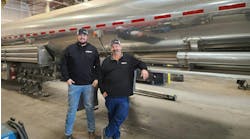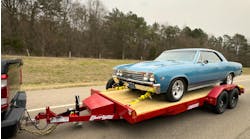Rapidly evolving networks enable greater communication, creating opportunities for carriers and providers to reap rewards
Emission control systems that make trucks cleaner and advanced drive-assistance systems that make them safer are critical technological advancements that have changed the trucking industry, mostly for the better.
They’re also old news in a rapidly changing tech landscape.
The latest and greatest trends center on big data and vehicle connectivity, and their potential to change the game completely.
“These two trends also will be fundamental stepping stones toward the next big trend, which will be self-driving trucks, which we believe we’ll see at least in Stage 4 automation probably by the middle of the next decade, and depending on legislation,” said Walter Rentzsch, principal with Munich, Germany-headquartered management consulting company Roland Berger.
Rentzsch, who’s based in the company’s Detroit MI office, explored connectivity issues, including the many benefits, technology enablers and profitable applications, during his presentation “Truck Connectivity: Huge Potential, but Unclear Path to Monetization” at FTR’s 2019 Transportation Conference.
Solutions oriented
Why should fleets care about truck connectivity? For starters, it helps optimize total cost of truck ownership, Rentzsch said. For example, trucking cost categories, with their potential connected solutions, include:
• Driver-associated expense—Interactive coaching can help drivers improve
• Fuel costs—Fuel usage coaching creates better awareness of fuel-saving factors
• Equipment—Over-the-air, on-the-road updates that decrease downtime
• Maintenance—Predictive diagnostics identify problems earlier
• Infrastructure—Time-saving weigh station bypasses
• Insurance—Driving style monitoring to lower premiums
“These obviously are not the only solutions out there,” Rentzsch said. “There’s a broad spectrum … (including) the traditional telematics solutions, like routing and navigation, more emerging solutions like driver monitoring and remote diagnostics, and then also some long-term solutions like platooning and, eventually, autonomous driving.”
Behind these solutions are the enabling technologies, including V2X (vehicle-to-everything) infrastructure, 4G and 5G networks, cloud computing, artificial intelligence, Edge computing, machine learning, in-cab monitoring devices, and smart sensors and actuators. The benefits of using these technologies in a connected industry include improved efficiency and cost savings, timely deliveries, reduced downtime, improved safety and security, and greater convenience.
Rentzsch said the most important enabler of truck connectivity is the telematics control unit (TCU), which bridges the hardware and software and connects trucks to other vehicles, fleet offices, infrastructure and more.
“At the heart of every connectivity solution is a control unit, which is linked into the CAN (controller area network) bus of the vehicle,” he maintained. “It gets different data types, from powertrain, for example, to (tracking) data, like where is the vehicle, what’s the speed of the vehicle, what direction is it going, and then also engine data.”
The evolving connectivity architecture involves two types of software: Native applications that typically come from the TCU provider, like route optimization and vehicle diagnostics; and third-party applications such as digital freight matching and e-tolling. They’re connected to various hardware, including GPS modules, digital displays, microphones and driver-monitoring devices through the control unit.
“Most players in the market, really, with a few exceptions, have gone to open platforms, where third-party applications can also be integrated into the system,” Rentzsch said. “The rationale behind this is that, A, there simply is not a one-fits-all solution, and secondly, you can keep development costs down by integrating a third-party partner.”
Evolving connections
The data to which connectivity provides actionable access includes non-time critical, “traditional” telematics services and time-critical safety communications, which necessitate different types of interfaces. With non-time critical data, like navigation, 3G and 4G cellular, and satellite-based services are sufficient, but with time-critical data, like collision warnings, “low-latency” interfaces are required for faster transmission.
“With these low-latency interfaces, you can’t really use the traditional systems, so you use either the DSRC (dedicated short range communication) system, which has been around for many, many years, or the other technology that is emerging recently, which is the cellular vehicle-to-everything (C-V2X) type of communication,” Rentzsch said.
C-V2X has evolved “quite a bit” over the last few years, he asserted, starting with the introduction of “fundamental” 4G LTE vehicle-to-network (V2N) technology, where vehicles communicate with network infrastructure over operator-licensed spectrums, in 2016, and followed by developments in 4G vehicle-to-vehicle (V2V) and vehicle-to-infrastructure (V2I) technology in 2017, 5G V2N in 2018, and 5G V2V and V2I this year.
Rentzsch said 5G chip sets are in development, testing is ongoing, and Roland Berger expects rollout and deployment of in-truck technology as early as next year.
“The real use case behind 5G will be related to safety and autonomous driving,” Rentzsch said. “So here, this short-range direct communication, increased bandwidth and even further-reduced latency is what will enable autonomous driving in the future. That will be the main driver behind the adoption of 5G.”
Connected services can be grouped into two main classes: Vehicle management solutions and transport management solutions. Vehicle management includes load monitoring, vehicle health and drive engagement; and transport management includes operations and logistics. And all these solutions currently sit across a broad spectrum of maturity, from those in their infancy, like remote vehicle access control, to fully developed systems, like vehicle tracking.
Hurdles to adopting all these connected solutions, particularly the fully automated, self-driving trucks that still divide public opinion, range from fear of upsetting the driver to concerns over data security and cyberattacks, and missing standards. “The key message is there is a lot more still in the pipeline that we’ll see in the next few years hitting the market,” Rentzsch said.
Clearly, he maintained, the market has evolved from basic telematics to wide-ranging fleet management solutions, and he sees connectivity trending toward the development of a fully connected supply chain, where “data is shared across all uses—the carriers, the shippers, the brokers, the warehouses, and even the freights” in the near future.
Roland Berger’s vision of the fully connected supply chain platforms of the future features:
• Fully connected freight supply chains
• Data shared across all users (carriers, shippers, brokers, etc.)
• Freight connected through smart sensors
• New solutions that leverage fleet management platforms
• Fully customizable solution sets for every customer
• Real-time 5G data feeds that enable deeper and broader access to data
Value analysis
It’s difficult to attach real numbers to the potential savings created by connectivity, Rentzsch said, but Roland Berger’s admittedly simplified attempts make it clear that potential, and the many benefits, have barely been tapped.
Considering connectivity can impact operating costs by increasing productivity, and reducing overtime, fuel expenses, total miles and idle time, Rentzsch estimates a 5% to 10% savings potential in a US Class 8 trucking industry with an annual operating cost of roughly $360 billion, which, multiplied by the industry standard EBITDA of 4.5, equals a massive connectivity “value pool” of between $82 and $163 billion every year.
“It shows you that there is a huge potential behind (connectivity), and it becomes interesting when you compare this to the size of the telematics market in the US,” he said. “It shows you that you’re really only seeing the tip of the iceberg. There is much more behind truck connectivity solutions than what we see today.”
So how do companies make money off connectivity and the data it provides?
The stages of the business model for the automotive data value stream include data generation, on-board processing, data transmission, off-board processing, service development, and service use; and the data access platform, which lies between off-board processing and service development, is the central market place where data is assigned value and monetized by three primary groups: Data providers who directly monetize data, intermediaries who sell supporting services and data users who sell data-enabled services.
Data providers include OEMs and companies that collect data, like traffic data, and then sell it; intermediaries include telecom companies, data transmitters and payment processors; and data users include analysts, service developers and service providers, who Rentzsch said are making money in the most obvious way.
“Players in the market, be it truck OEMs or component suppliers, are trying to fit their sweet spots, and they want to figure out what part of this value chain should I cover, and can I actually cover, in the future,” Rentzsch said.










